Detoxifying the home
Activated carbon and zeolite
helps prevent toxin exposure
helps prevent toxin exposure
- How can toxins get into the laundry machine?Toxins, like BPA, can leach from clothing when microplastics are created in a standard laundry washing machine.
Our lab has reproduced and extended the study of BPA leaching from everyday clothing and sportswear.
It's recommended to avoid synthetic clothing where possible, but that's not always possible. Synthetic clothing is a part of modern living and clothing needs to be washed. 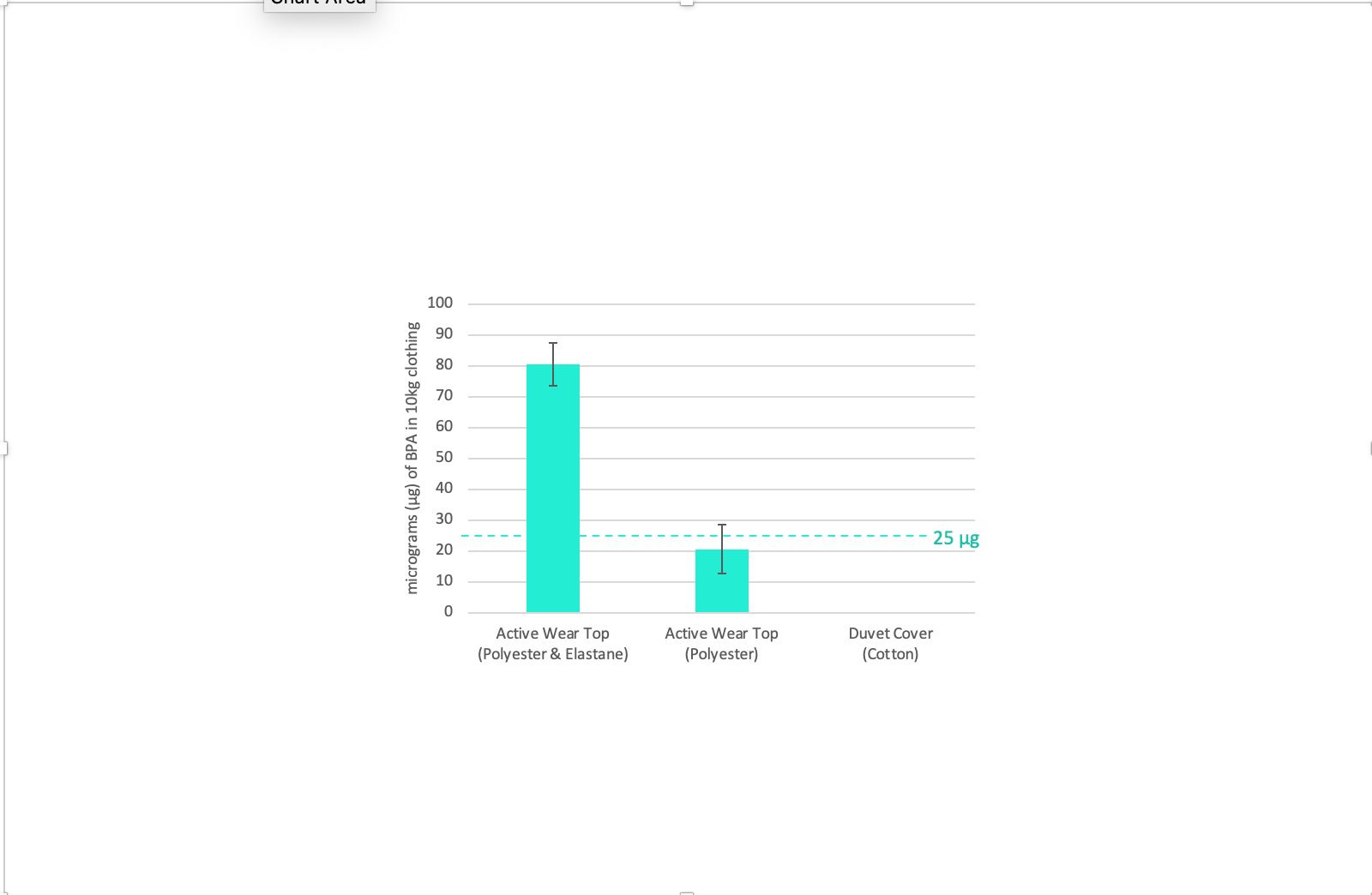 Lab testing: BPA eluted from common clothing (with 25µg level in a 50L wash volume is highlighted as this corresponds to the magnitude of the BPA spike used in all simulated lab testing)
Lab testing: BPA eluted from common clothing (with 25µg level in a 50L wash volume is highlighted as this corresponds to the magnitude of the BPA spike used in all simulated lab testing) Lab testing: BPA eluted from common clothing (with 25µg level in a 50L wash volume is highlighted as this corresponds to the magnitude of the BPA spike used in all simulated lab testing)How much BPA can leach from synthetic clothing?Everyday clothing was subjected to our BPA recovery methods, and the following results (at left) show that BPA is most prevalent on synthetics (like active wear tops).
Lab testing: BPA eluted from common clothing (with 25µg level in a 50L wash volume is highlighted as this corresponds to the magnitude of the BPA spike used in all simulated lab testing)How much BPA can leach from synthetic clothing?Everyday clothing was subjected to our BPA recovery methods, and the following results (at left) show that BPA is most prevalent on synthetics (like active wear tops).
Our methods of BPA recovery agree with prior methods claimed by the Center for Environmental Health, which claim >40x the allowable daily limit of BPA being leached from common sportswear brands.
https://actionnetwork.org/petitions/bpa-in-clothes- Activated carbon binds toxins in test washes in the presence of detergentIt's well reported that toxins like BPA, PFAS, and many other harmful substances can be removed at extremely low levels by using the adsorbent property of materials like activated carbon.
FabricNano has shown that this capture of toxins is possible in a detergent test wash environment, by investigating and tracking concentrations of the toxin Bisphenol-A (commonly known as BPA).
To fight back against BPA in the wash, FabricNano suggests using a combination of activated carbon (to bind toxin), zeolite (with potential to trap toxin) and laccase enzyme (with potential to oxidize and neutralize the toxin).
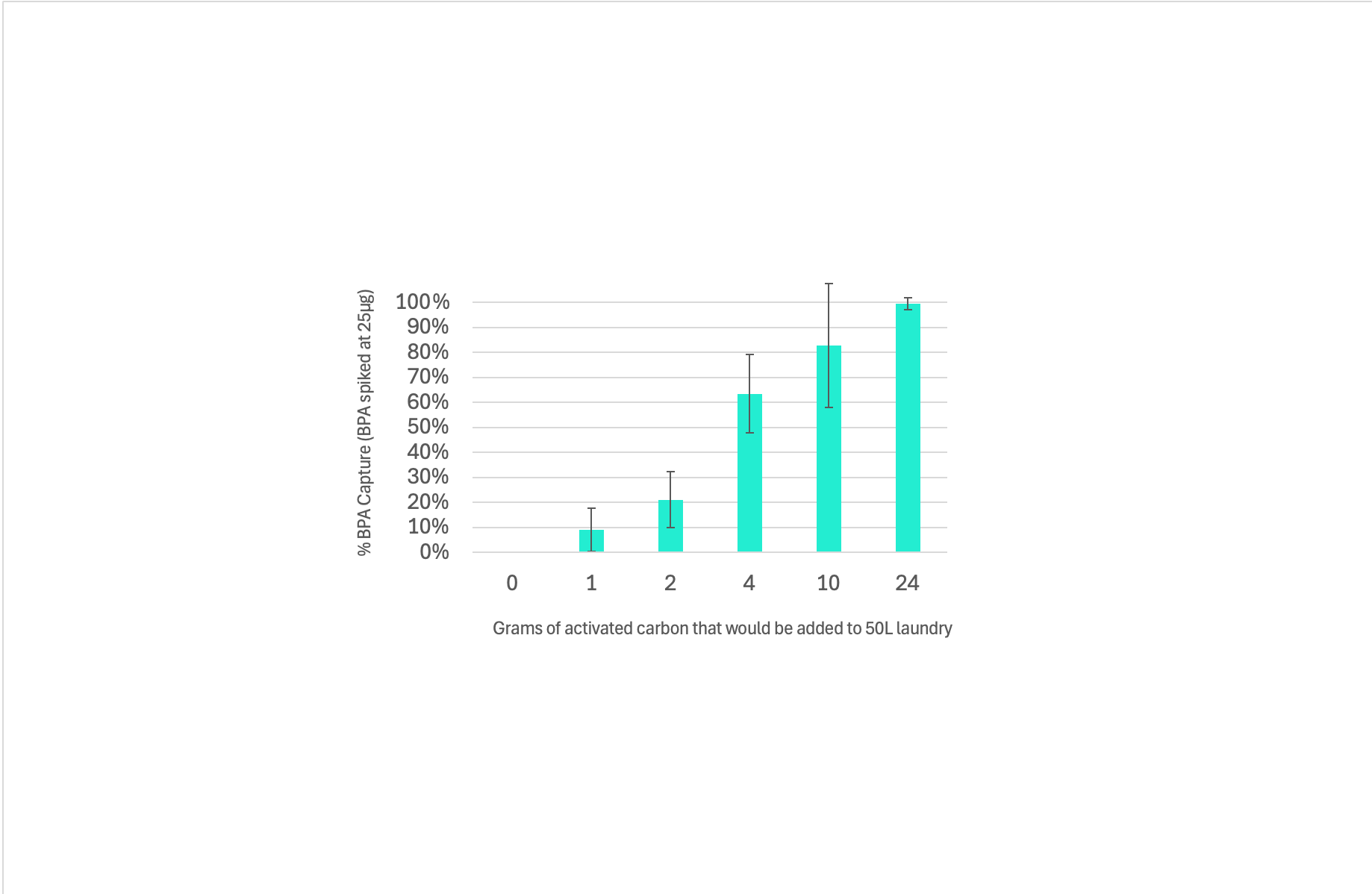 Lab testing: BPA spiked at 0.5ng/mL into water and detergent, incubated in shaker at 30C for 1hr (x-axis rounded to nearest 0.5g)
Lab testing: BPA spiked at 0.5ng/mL into water and detergent, incubated in shaker at 30C for 1hr (x-axis rounded to nearest 0.5g) Lab testing: BPA spiked at 0.5ng/mL into water and detergent, incubated in shaker at 30C for 1hr (x-axis rounded to nearest 0.5g)How much BPA can bind to activated carbon?For simplicity, we show the effect of increasing amounts of activated carbon in binding (and removing) a known level of spiked BPA toxin from the water with detergent.
Lab testing: BPA spiked at 0.5ng/mL into water and detergent, incubated in shaker at 30C for 1hr (x-axis rounded to nearest 0.5g)How much BPA can bind to activated carbon?For simplicity, we show the effect of increasing amounts of activated carbon in binding (and removing) a known level of spiked BPA toxin from the water with detergent.
In laboratory test washes, activated carbon needs to be used at more than 4g for a 50L laundry wash cycle in order to capture more than 50% of BPA, which in these examples is spiked at a level of 25µg in 50L (or 0.5ng/mL).- How much BPA can be trapped in a proprietary blend of zeolite?For simplicity, we show the effect of increasing amounts of a selected zeolite in trapping (and removing) a known level of spiked BPA toxin from the water with detergent.
In laboratory test washes, zeolite needs to be used at more than 5g for a 50L laundry wash cycle in order to capture more than 75% of BPA, which in these examples is spiked at a level of 25µg in 50L (or 0.5ng/mL). 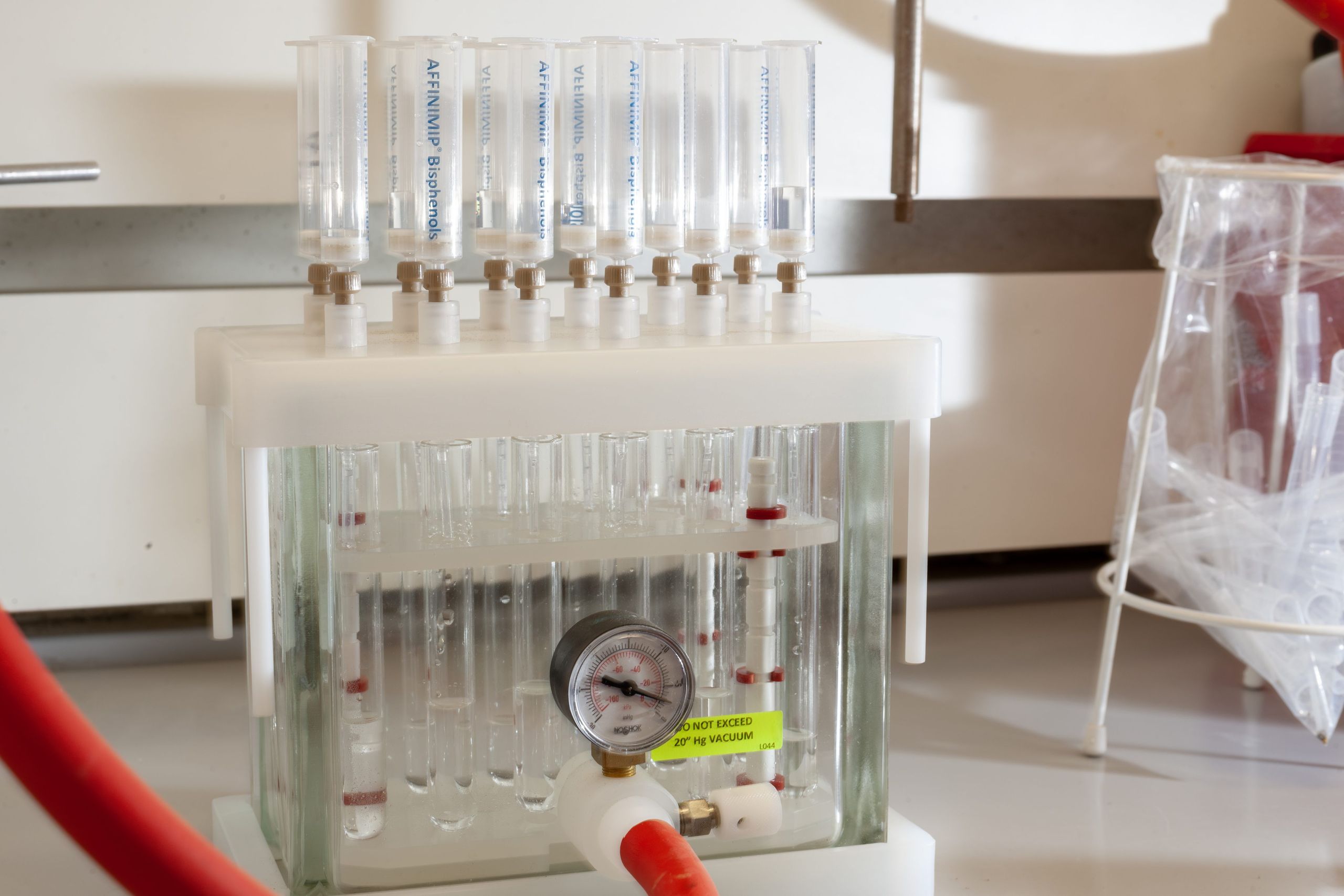 SPE manifold used to concentrate BPA and detect <1ng/mL
SPE manifold used to concentrate BPA and detect <1ng/mL SPE manifold used to concentrate BPA and detect <1ng/mLMethods to extract BPATo study BPA in aqueous solutions like wash water, you must purify and concentrate it for detection. FabricNano isolates BPA is from aqueous solutions by Solid Phase Extraction (SPE). This technique involves passing the aqueous solution down a column which selectively catches BPA, allowing water and impurities to flow through. The BPA can then be washed off the column using an organic solvent which dissolves it effectively, leaving you with a much purer and more concentrated solution.
SPE manifold used to concentrate BPA and detect <1ng/mLMethods to extract BPATo study BPA in aqueous solutions like wash water, you must purify and concentrate it for detection. FabricNano isolates BPA is from aqueous solutions by Solid Phase Extraction (SPE). This technique involves passing the aqueous solution down a column which selectively catches BPA, allowing water and impurities to flow through. The BPA can then be washed off the column using an organic solvent which dissolves it effectively, leaving you with a much purer and more concentrated solution.- Measurement of BPAOnce BPA has been extracted, the samples are analysed by Liquid Chromatography–Mass Spectrometry (LC–MS). This method pinpoints and detects BPA in a sample in two steps:
1. High-Performance Liquid Chromatography (HPLC): The sample is added to a column which will interact differently with each chemical in the mixture, depending on its structure. Chemicals therefore move through at different rates when solvent is flowed. BPA will emerge after the same delay each time.
2. Mass Spectrometry (MS): The mass of the molecules are analysed as they come off the HPLC column. Signal is detected for BPA’s characteristic mass, at the time it comes off the column. This detection method is highly sensitive, and can detect BPA molecules at very low concentrations (< 1ng/mL). 
 Lab-based test washes at FabricNanoHow can toxins get into the laundry machine?Toxins, like BPA, can leach from clothing when microplastics are created in a standard laundry washing machine.
Lab-based test washes at FabricNanoHow can toxins get into the laundry machine?Toxins, like BPA, can leach from clothing when microplastics are created in a standard laundry washing machine.
Our lab has reproduced and extended the study of BPA leaching from everyday clothing and sportswear.
It's recommended to avoid synthetic clothing where possible, but that's not always possible. Synthetic clothing is a part of modern living and clothing needs to be washed.
 Lab testing: BPA eluted from common clothing (with 25µg level in a 50L wash volume is highlighted as this corresponds to the magnitude of the BPA spike used in all simulated lab testing)How much BPA can leach from synthetic clothing?Everyday clothing was subjected to our BPA recovery methods, and the following results (at left) show that BPA is most prevalent on synthetics (like active wear tops).
Lab testing: BPA eluted from common clothing (with 25µg level in a 50L wash volume is highlighted as this corresponds to the magnitude of the BPA spike used in all simulated lab testing)How much BPA can leach from synthetic clothing?Everyday clothing was subjected to our BPA recovery methods, and the following results (at left) show that BPA is most prevalent on synthetics (like active wear tops).
Our methods of BPA recovery agree with prior methods claimed by the Center for Environmental Health, which claim >40x the allowable daily limit of BPA being leached from common sportswear brands.
https://actionnetwork.org/petitions/bpa-in-clothes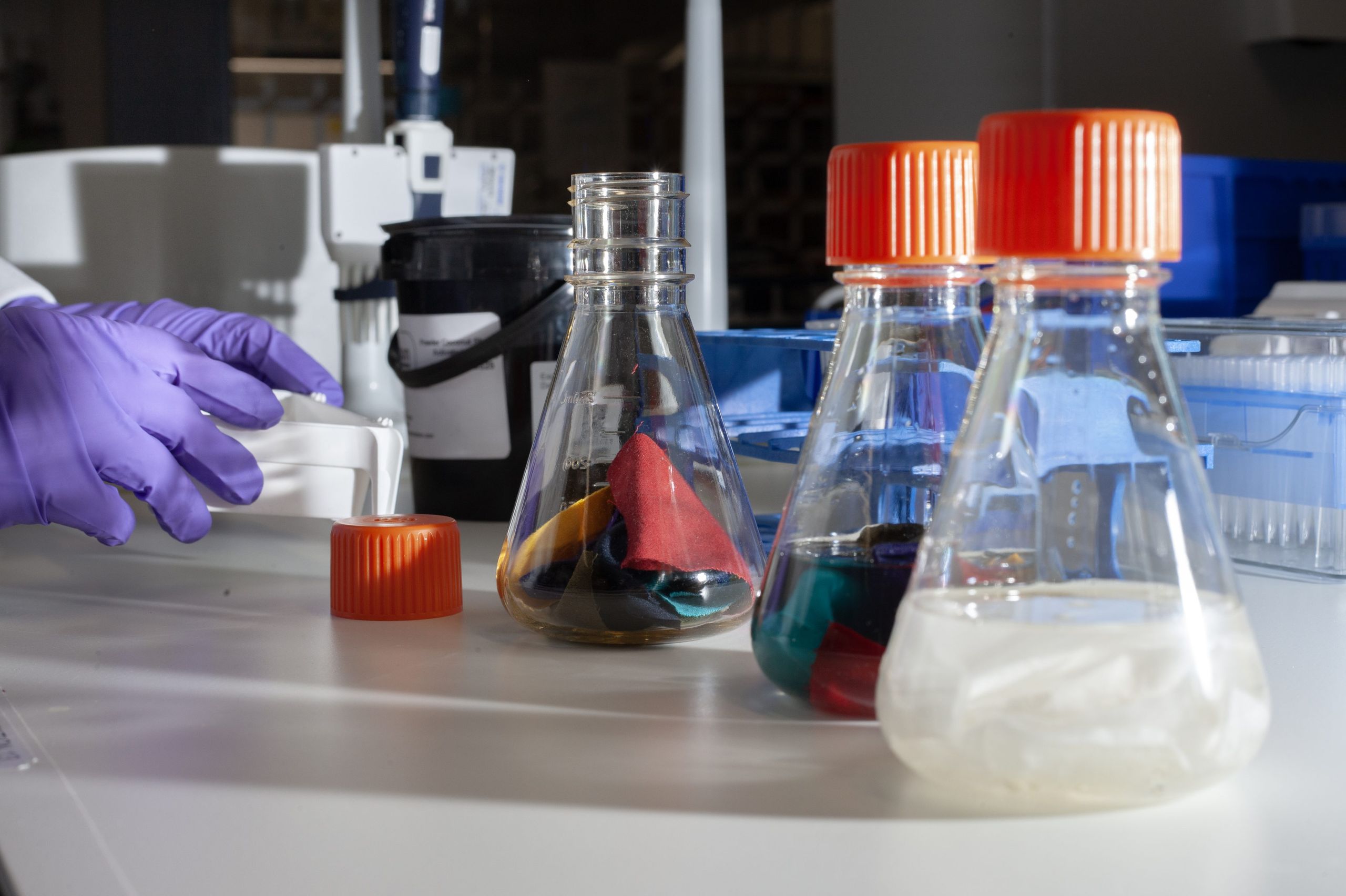
 Lab-based test washes at FabricNanoActivated carbon binds toxins in test washes in the presence of detergentIt's well reported that toxins like BPA, PFAS, and many other harmful substances can be removed at extremely low levels by using the adsorbent property of materials like activated carbon.
Lab-based test washes at FabricNanoActivated carbon binds toxins in test washes in the presence of detergentIt's well reported that toxins like BPA, PFAS, and many other harmful substances can be removed at extremely low levels by using the adsorbent property of materials like activated carbon.
FabricNano has shown that this capture of toxins is possible in a detergent test wash environment, by investigating and tracking concentrations of the toxin Bisphenol-A (commonly known as BPA).
To fight back against BPA in the wash, FabricNano suggests using a combination of activated carbon (to bind toxin), zeolite (with potential to trap toxin) and laccase enzyme (with potential to oxidize and neutralize the toxin).

 Lab testing: BPA spiked at 0.5ng/mL into water and detergent, incubated in shaker at 30C for 1hr (x-axis rounded to nearest 0.5g)How much BPA can bind to activated carbon?For simplicity, we show the effect of increasing amounts of activated carbon in binding (and removing) a known level of spiked BPA toxin from the water with detergent.
Lab testing: BPA spiked at 0.5ng/mL into water and detergent, incubated in shaker at 30C for 1hr (x-axis rounded to nearest 0.5g)How much BPA can bind to activated carbon?For simplicity, we show the effect of increasing amounts of activated carbon in binding (and removing) a known level of spiked BPA toxin from the water with detergent.
In laboratory test washes, activated carbon needs to be used at more than 4g for a 50L laundry wash cycle in order to capture more than 50% of BPA, which in these examples is spiked at a level of 25µg in 50L (or 0.5ng/mL).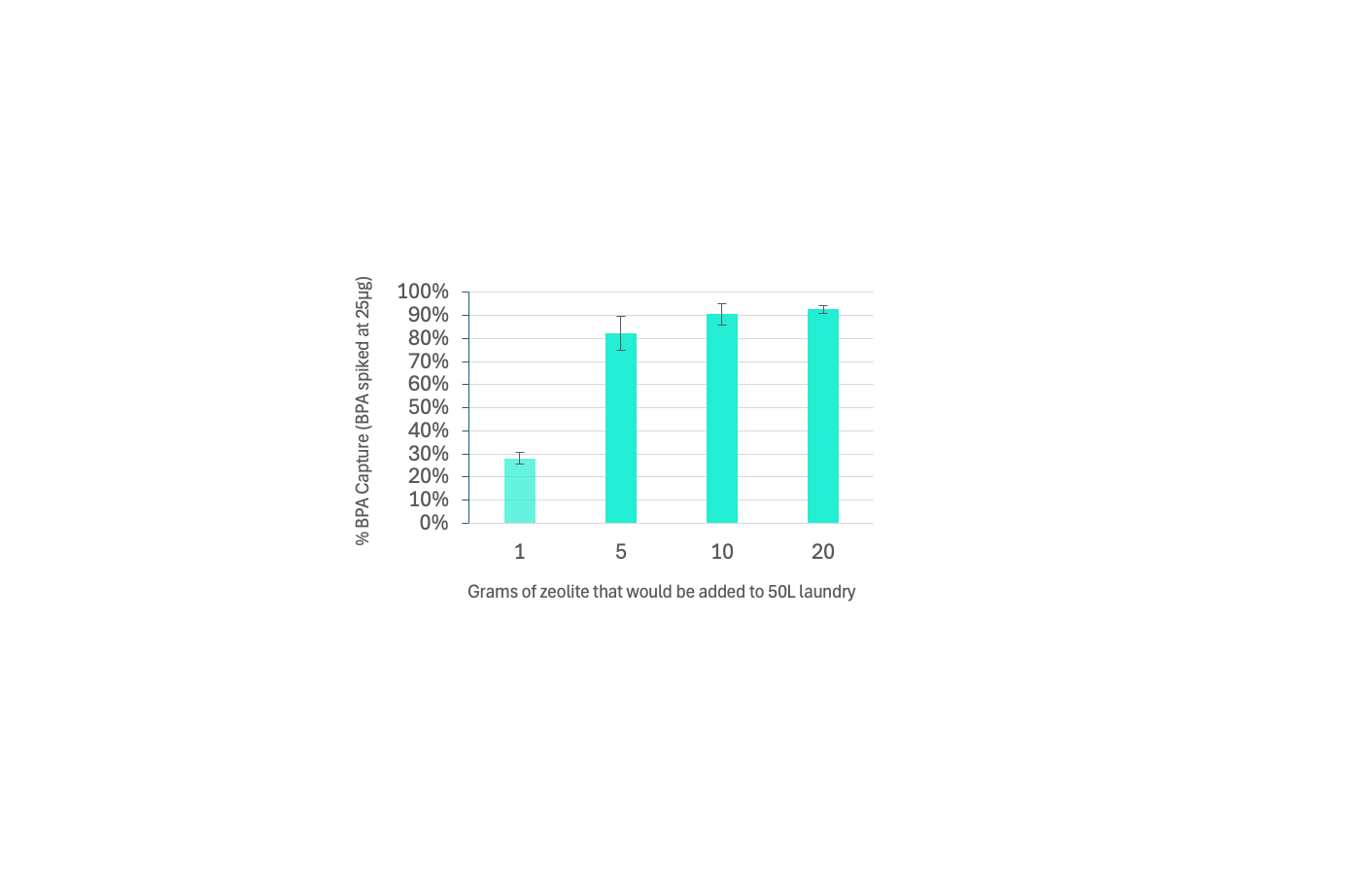
 Lab testing: BPA spiked at 0.5ng/mL into water and detergent, incubated in shaker at 30C for 1hr (x-axis rounded to nearest 0.5g)How much BPA can be trapped in a proprietary blend of zeolite?For simplicity, we show the effect of increasing amounts of a selected zeolite in trapping (and removing) a known level of spiked BPA toxin from the water with detergent.
Lab testing: BPA spiked at 0.5ng/mL into water and detergent, incubated in shaker at 30C for 1hr (x-axis rounded to nearest 0.5g)How much BPA can be trapped in a proprietary blend of zeolite?For simplicity, we show the effect of increasing amounts of a selected zeolite in trapping (and removing) a known level of spiked BPA toxin from the water with detergent.
In laboratory test washes, zeolite needs to be used at more than 5g for a 50L laundry wash cycle in order to capture more than 75% of BPA, which in these examples is spiked at a level of 25µg in 50L (or 0.5ng/mL).
 SPE manifold used to concentrate BPA and detect <1ng/mLMethods to extract BPATo study BPA in aqueous solutions like wash water, you must purify and concentrate it for detection. FabricNano isolates BPA is from aqueous solutions by Solid Phase Extraction (SPE). This technique involves passing the aqueous solution down a column which selectively catches BPA, allowing water and impurities to flow through. The BPA can then be washed off the column using an organic solvent which dissolves it effectively, leaving you with a much purer and more concentrated solution.
SPE manifold used to concentrate BPA and detect <1ng/mLMethods to extract BPATo study BPA in aqueous solutions like wash water, you must purify and concentrate it for detection. FabricNano isolates BPA is from aqueous solutions by Solid Phase Extraction (SPE). This technique involves passing the aqueous solution down a column which selectively catches BPA, allowing water and impurities to flow through. The BPA can then be washed off the column using an organic solvent which dissolves it effectively, leaving you with a much purer and more concentrated solution.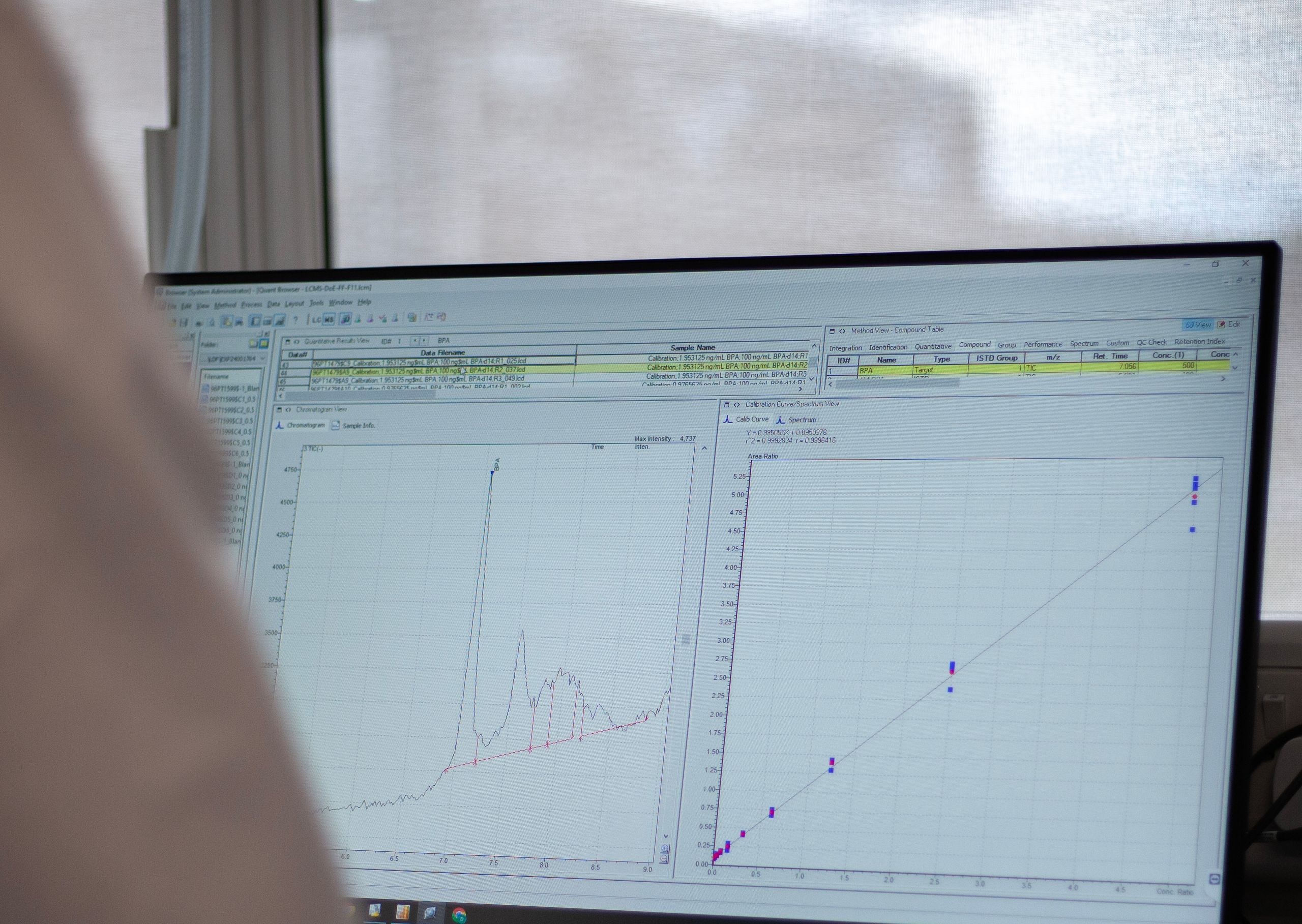
 High Performance Liquid Chromatography (HPLC) to as readout for measuring BPAMeasurement of BPAOnce BPA has been extracted, the samples are analysed by Liquid Chromatography–Mass Spectrometry (LC–MS). This method pinpoints and detects BPA in a sample in two steps:
High Performance Liquid Chromatography (HPLC) to as readout for measuring BPAMeasurement of BPAOnce BPA has been extracted, the samples are analysed by Liquid Chromatography–Mass Spectrometry (LC–MS). This method pinpoints and detects BPA in a sample in two steps:
1. High-Performance Liquid Chromatography (HPLC): The sample is added to a column which will interact differently with each chemical in the mixture, depending on its structure. Chemicals therefore move through at different rates when solvent is flowed. BPA will emerge after the same delay each time.
2. Mass Spectrometry (MS): The mass of the molecules are analysed as they come off the HPLC column. Signal is detected for BPA’s characteristic mass, at the time it comes off the column. This detection method is highly sensitive, and can detect BPA molecules at very low concentrations (< 1ng/mL).